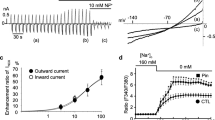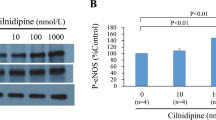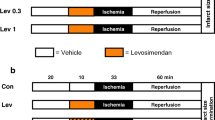Abstract
Nicorandil, a hybrid of nitrate generator and potassium channel opener, protects ischemic myocardium by opening mitochondrial ATP sensitive potassium (mitoKATP) channels. We recently found that nitric oxide (NO) opened KATP channels in rabbit hearts by a protein kinase G (PKG) mechanism. This study examined whether the NO-donor property of nicorandil also contributes to opening of mitoKATP channels through PKG. MitoKATP channel opening was monitored in adult rabbit cardiomyocytes by measuring reactive oxygen species (ROS) production, an established marker of channel opening. Nicorandil increased ROS production in a dose-dependent manner. The selective mitoKATP channel inhibitor 5-hydroxydecanoate (200 μM) completely blocked ROS production by nicorandil at all doses. The PKG inhibitor 8-bromoguanosine-3’,5’-cyclic monophosphorothioate, Rpisomer (Rp-8-Br-cGMPs, 50 μM) shifted the dose-ROS production curve to the right with an increase of the EC50 from 2.4 x 10–5 M to 6.9 x 10–5 M. Rp- 8-Br-cGMPs did not affect the increase in ROS production by the selective mitoKATP channel opener diazoxide while it completely blocked increased ROS production from the NO donor S-nitroso-N-acetylpenicillamine (1 μM). Furthermore ODQ, an antagonist of soluble guanylyl cyclase, blocked nicorandil’s ability to increase ROS generation. These results indicate that nicorandil, in addition to its direct effect on the channels, opens mitoKATP channels indirectly via a NO-PKG signaling pathway.
Similar content being viewed by others
References
Akao M, Teshima Y, Marbán E (2002) Antiapoptotic effect of nicorandil mediated by mitochondrial ATP-sensitive potassium channels in cultured cardiac myocytes. J Am Coll Cardiol 40:803–810
Costa ADT, Garlid KD, West IC, Lincoln TM, Downey JM, Cohen MV, Critz SD (2005) Protein kinase G transmits the cardioprotective signal from cytosol to mitochondria. Circ Res 97:329–336
Dairaku Y, Miura T, Harada N, Kimura M, Okamura T, Iwamoto H, Kametani R, Yamada M, Ikeda Y, Iwatate M, Kawamura S, Matsuzaki M (2002) Effect of ischemic preconditioning and mitochondrial KATP channel openers on chronic left ventricular remodeling in the ischemic- reperfused rat heart. Circ J 66:411–415
Das B, Sarkar C (2003) Mitochondrial KATP channel activation is important in the antiarrhythmic and cardioprotective effects of non-hypotensive doses of nicorandil and cromakalim during ischemia/ reperfusion: a study in an intact anesthetized rabbit model. Pharmacol Res 47:447–461
Endo T, Nejima J, Kiuchi K, Fujita S, Kikuchi K, Hayakawa H, Okumura H (1988) Reduction of size of myocardial infarction with nicorandil, a new antianginal drug, after coronary artery occlusion in dogs. J Cardiovasc Pharmacol 12:587–592
Endoh M, Iijima T (1983) Effects of nicorandil and its interaction with isoproterenol on force of contraction and cyclic nucleotide levels of canine atrial muscle: comparison with carbachol. J Cardiovasc Pharmacol 5:878–882
Harada N, Miura T, Dairaku Y, Kametani R, Shibuya M, Wang R, Kawamura S, Matsuzaki M (2004) NO donoractivated PKC-δ plays a pivotal role in ischemic myocardial protection through accelerated opening of mitochondrial K-ATP channels. J Cardiovasc Pharmacol 44:35–41
Holzmann S (1983) Cyclic GMP as possible mediator of coronary arterial relaxation by nicorandil (SG-75). J Cardiovasc Pharmacol 5:364–370
Imagawa J-i, Baxter GF, Yellon DM (1998) Myocardial protection afforded by nicorandil and ischaemic preconditioning in a rabbit infarct model in vivo. J Cardiovasc Pharmacol 31:74–79
IONA Study Group (2002) Effect of nicorandil on coronary events in patients with stable angina: the Impact Of Nicorandil in Angina (IONA) randomised trial. Lancet 359:1269–1275
Iwamoto T, Miura T, Urabe K, Itoya M, Shimamoto K, Iimura O (1993) Effect of nicorandil on post-ischaemic contractile dysfunction in the heart: roles of its ATP-sensitive K+ channel opening property and nitrate property. Clin Exp Pharmacol Physiol 20:595–602
Krenz M, Oldenburg O, Wimpee H, Cohen MV, Garlid KD, Critz SD, Downey JM, Benoit JN (2002) Opening of ATPsensitive potassium channels causes generation of free radicals in vascular smooth muscle cells. Basic Res Cardiol 97:365–373
Krieg T, Qin Q, Philipp S, Alexeyev MF, Cohen MV, Downey JM (2004) Acetylcholine and bradykinin trigger preconditioning in the heart through a pathway that includes Akt and NOS. Am J Physiol 287:H2606–H2611
Mizumura T, Nithipatikom K, Gross GJ (1996) Infarct size-reducing effect of nicorandil is mediated by the KATP channel but not by its nitrate-like properties in dogs. Cardiovasc Res 32:274–285
Nagata K, Obata K, Odashima M, Yamada A, Somura F, Nishizawa T, Ichihara S, Izawa H, Iwase M, Hayakawa A, Murohara T, Yokota M (2003) Nicorandil inhibits oxidative stress-induced apoptosis in cardiac myocytes through activation of mitochondrial ATP-sensitive potassium channels and a nitratelike effect. J Mol Cell Cardiol 35:1505–1512
National Research Council (1996) Guide for the Care and Use of Laboratory Animals. 7th ed. National Academy Press,Washington,DC
Ohno Y, Minatoguchi S, Uno Y, Kariya T, Arai M, Yamashita K, Fujiwara T, Fujiwara H (1997) Nicorandil reduces myocardial infarct size by opening the KATP channel in rabbits. Int J Cardiol 62:181–190
Oldenburg O, Cohen MV, Downey JM (2003) Mitochondrial KATP channels in preconditioning. J Mol Cell Cardiol 35:569–575
Oldenburg O, Critz SD, Cohen MV, Downey JM (2003) Acetylcholine-induced production of reactive oxygen species in adult rabbit ventricular myocytes is dependent on phosphatidylinositol 3- and Src-kinase activation and mitochondrial KATP channel opening. J Mol Cell Cardiol 35:653–660
Oldenburg O, Qin Q,Krieg T,Yang X-M, Philipp S, Critz SD, Cohen MV, Downey JM (2004) Bradykinin induces mitochondrial ROS generation via NO, cGMP, PKG, and mitoKATP channel opening and leads to cardioprotection. Am J Physiol 286:H468–H476
Qin Q, Yang X-M, Cui L, Critz SD, Cohen MV, Browner NC, Lincoln TM, Downey JM (2004) Exogenous NO triggers preconditioning via a cGMP- and mitoKATP-dependent mechanism. Am J Physiol 287:H712–H718
Sakai K, Akima M, Saito K, Saitoh M, Matsubara S (2000) Nicorandil metabolism in rat myocardial mitochondria. J Cardiovasc Pharmacol 35:723–728
Sakai K, Moriyasu M, Kitajima S, Akima M, Kamachi S, Tanikawa M (1998) Vascular levels and cGMP-increasing effects of nicorandil administered orally to rats. J Cardiovasc Pharmacol 31:595–600
Sakai K, Tsuchiya Y, Kitajima S, Hamada H (1999) Myocardial distribution and biotransformation in vitro and in vivo of nicorandil in rats, with special reference to mitochondria. J Cardiovasc Pharmacol 33:163–168
Sato T, Sasaki N, O’Rourke B, Marbán E (2000) Nicorandil, a potent cardioprotective agent, acts by opening mitochondrial ATP-dependent potassium channels. J Am Coll Cardiol 35:514–518
Taira N (1989) Nicorandil as a hybrid between nitrates and potassium channel activators. Am J Cardiol 63:18J–24J
Tsuchida A, Miura T, Tanno M, Sakamoto J, Miki T, Kuno A, Matsumoto T, Ohnuma Y, Ichikawa Y, Shimamoto K (2002) Infarct size limitation by nicorandil: roles of mitochondrial KATP channels, sarcolemmal KATP channels, and protein kinase C J Am Coll Cardiol 40:1523–1530
Yanagisawa T, Hashimoto H, Taira N (1988) The negative inotropic effect of nicorandil is independent of cyclic GMP changes: a comparison with pinacidil and cromakalim in canine atrial muscle. Br J Pharmacol 95:393–398
Author information
Authors and Affiliations
Corresponding author
Rights and permissions
About this article
Cite this article
Kuno, A., Critz, S.D., Cohen, M.V. et al. Nicorandil opens mitochondrial KATP channels not only directly but also through a NO-PKG-dependent pathway. Basic Res Cardiol 102, 73–79 (2007). https://doi.org/10.1007/s00395-006-0612-5
Received:
Revised:
Accepted:
Published:
Issue Date:
DOI: https://doi.org/10.1007/s00395-006-0612-5




